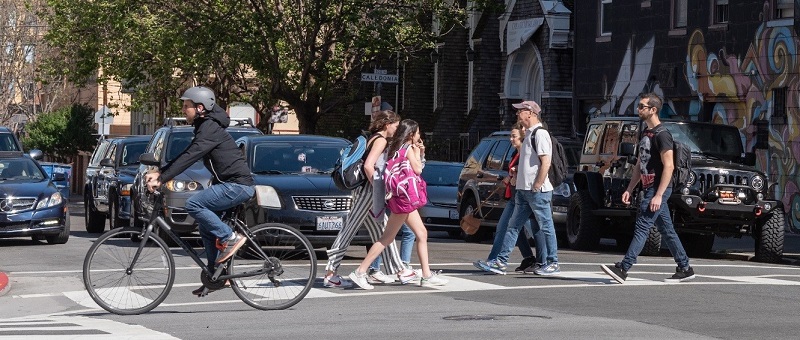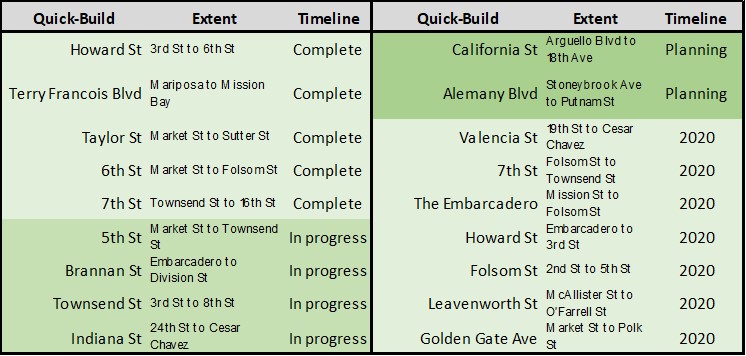Vision Zero Update
Vision Zero Update
By

It’s nationally been tragic news: traffic fatalities, especially for pedestrians, are on the rise. After decades of progress, the numbers are closer to 1989 than 2009, and the most vulnerable road users- pedestrians, children and seniors- are killed in the thousands annually across the country. Locally, we’ve lost 24 people to traffic deaths on our streets as of October 2019, 14 of those while walking.
The costs of these preventable incidents extend beyond loss of life alone. Families are left devastated and first responders carry deep emotional burdens. Second to the emotional impact is the fiscal cost of responding to and treating injuries from traffic collisions. Whereas annual medical costs related to treating pedestrian injuries at San Francisco General Hospital is 15 million dollars, total health-related costs that can be attributed to pedestrian injuries exceeds 500 million dollars.
Each lost life is one too many. The SFMTA, with sister departments the Department of Public Health and the San Francisco Police Department and with leadership from the Mayor’s Office and the Board of Supervisors, is committed to making streets safer as quickly as possible.
This February, the City released the 2019 Vision Zero Action Strategy. It prioritizes the strategies that make the biggest difference in safety, including clear actions that the city is taking, and transformative policies that need state-level change. We’ve been making strong progress on many of our actions: legislating a full private-vehicle closure on Market Street, working with the Bayview community on advancing transportation safety in their community, and expanding the City’s Safe Routes to Schools program to every SF Unified School District elementary school.
However, we understand safer streets can’t come quickly enough. As Mayor London Breed told us earlier this year, “the current pace of traffic safety improvements in San Francisco is unacceptable and I refuse to allow red tape and bureaucracy to stop us from taking immediate, common-sense steps to improve safety while we undergo long-term improvements.” SFMTA has committed to finding ways to getting safety improvements in the ground as fast as possible, including expanding our engineering commitments.
Quick-Build Corridor Improvements
In June, SFMTA adopted the quick-build policy - with basic changes to the Transportation Code, SFMTA can now design, legislate, and implement projects with significant time savings. With timelines reduced by as many as seven months, several vital quick-build safety projects have been implemented since the new policy was adopted earlier this year, including 6th Street, Taylor Street and segments of Townsend Street. The 7th Street protected bikeway was implemented in as few as 10 weeks.
SFMTA has quadrupled our initial quick-build commitments, with a new promise of delivering 10 projects in 2019. With an original goal of building eight miles of sustainable travel lanes annually, with the Mayor’s leadership, the agency additionally now commits to installing 20 miles of protected bikeways in the next two years.

Making Intersections Safer
We are not only focusing on corridor projects. With essential input from the Board of Supervisors and passionate advocates, we are re-thinking how our intersections on the high-injury network should be designed. 60% of collisions occur in an intersection, and engineering tools can improve visibility, facilitate crossing and reduce vehicle speeds.
For example, this year, the North of Market/ South of Market signal project will re-time one-third of the city’s traffic signals for slower driving speeds, longer crossing times and pedestrian head starts. In the Tenderloin, last weekend SFMTA installed 9 pedestrian ‘scrambles’ – a pedestrian-only traffic signal phase that makes it safe for people to cross without conflict from turning vehicles.
Other programmatic intersection improvements that engineers are working on across the city include high-visibility crosswalks and daylighting intersections, making pedestrians more visible to drivers when crossing the street.
Continued Partnership and Commitment
San Francisco is a leader in the safe streets movement and uses a data-driven, evidence-based approach to save lives. Through a partnership with the Department of Public Health, the city is looking to expand its intersection traffic calming tool kit with an upcoming pilot study to consider left-turn traffic calming treatments as well as developing policy recommendations for turn restrictions on red.
SFMTA also works directly with the San Francisco Police Department for focused enforcement on known high-injury streets, and on the causes that are most likely to result in a severe injury and fatalities – speeding, failure to yield and running STOP signs or red lights. SFMTA Parking Control Officers complement SFPD enforcement efforts by enforcing no stopping in bike lanes, double-parking and parking in bus zones.
We’re also working with the State of California, to make progress on some of our transformative policy goals. SFMTA is a member of the State’s Zero Traffic Fatalities Task Force, where recommendations will be made to legislators about changes to speed limit setting and speed enforcement at the end of this year.
With strong local leadership, dedicated staff and advocates, broad city partnership and an action strategy grounded in proven policy, San Francisco will continue to pursue all efforts in the areas they are most needed in order to protect everyone who lives, works or visits the City from traffic-related injury.
Published October 22, 2019 at 04:51PM
https://ift.tt/2oVplSs

0 Comments:
Post a Comment
Subscribe to Post Comments [Atom]
<< Home